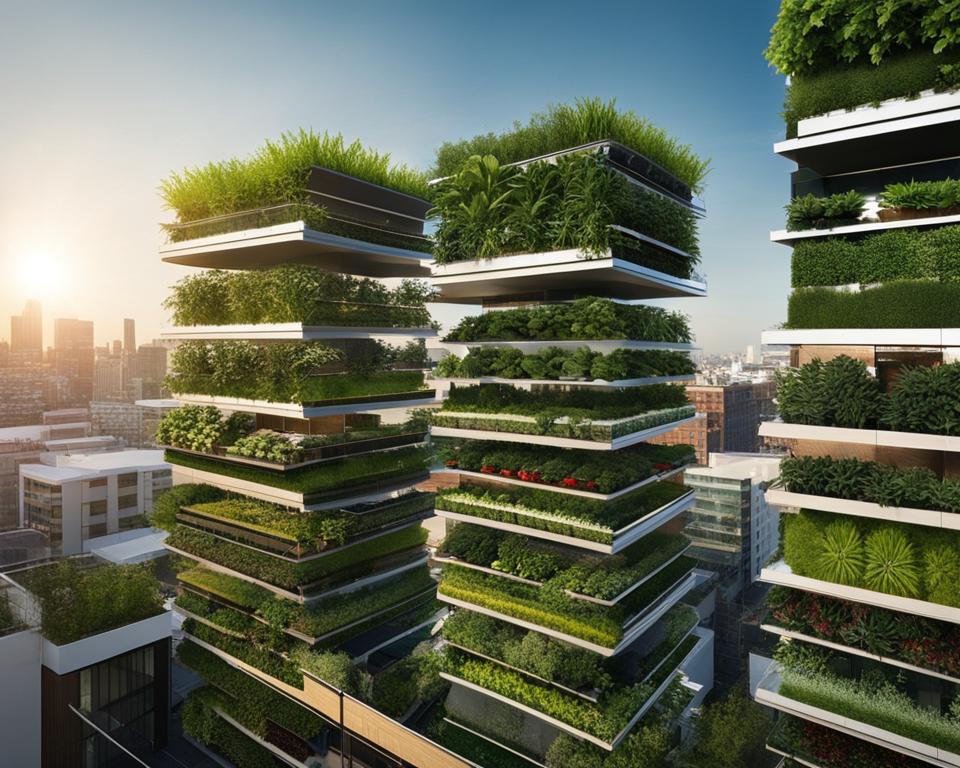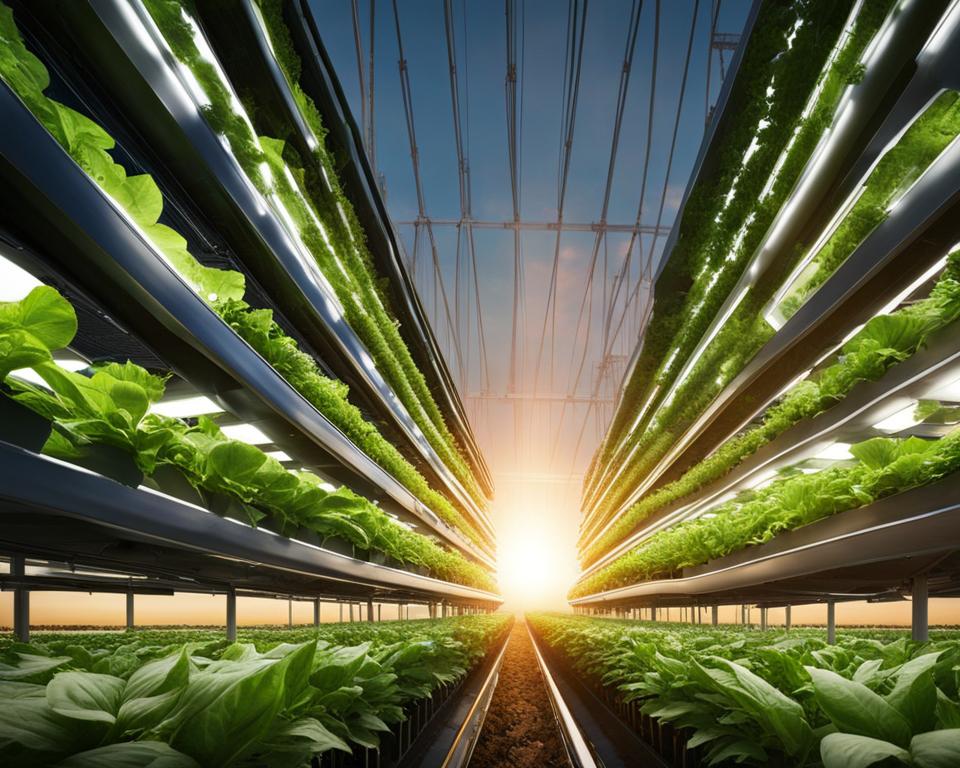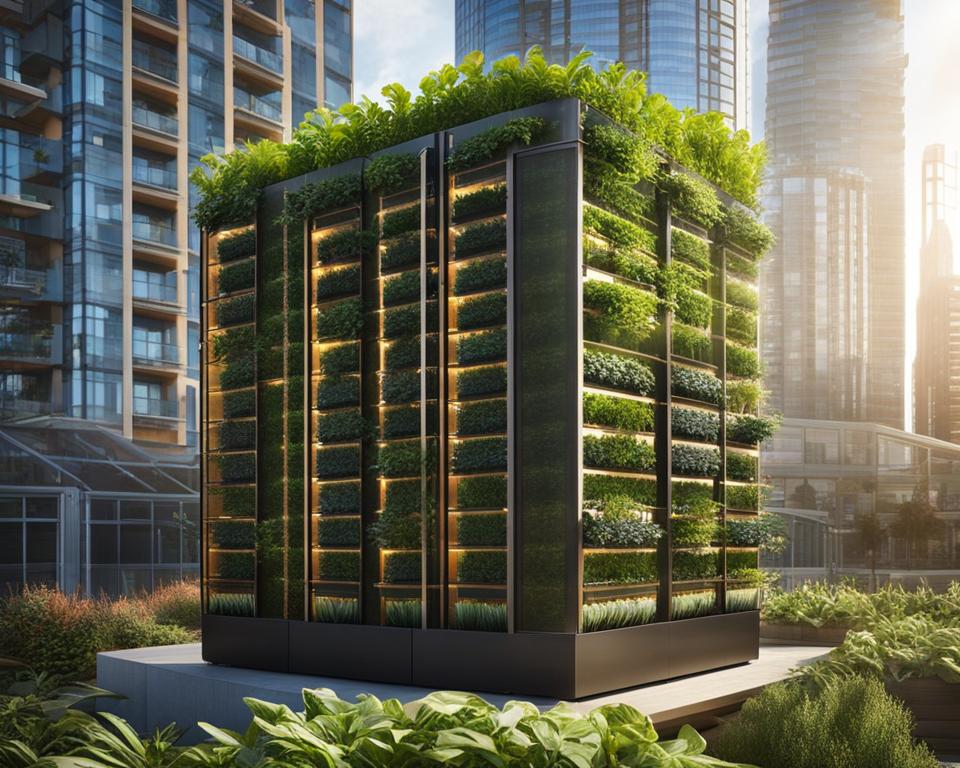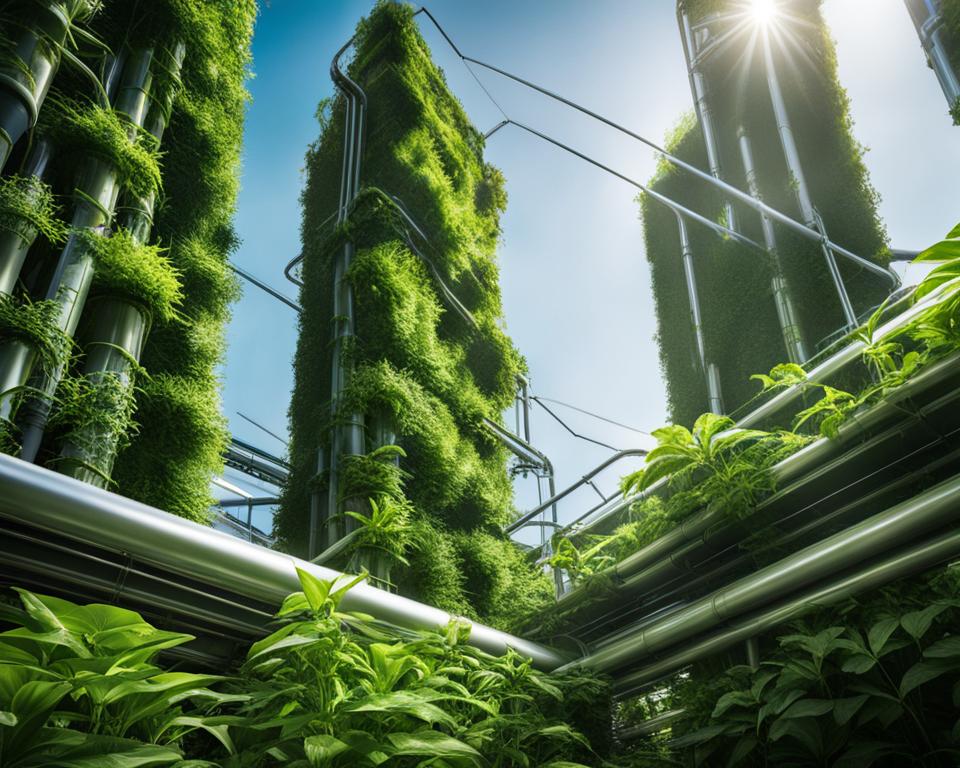The global market for commercial vertical gardening systems is experiencing rapid growth, revolutionizing sustainable urban agriculture. With commercial indoor gardening and commercial hydroponic systems at the forefront of vertical gardening technology, we are witnessing a shift towards more efficient and environmentally-friendly food production methods.
As cities continue to expand, the demand for locally sourced and sustainable food increases. Commercial vertical farming offers a solution by maximizing space utilization, reducing emissions, and providing abundant food. This innovative approach to farming has been influenced by the research conducted by NASA, paving the way for startups like Plenty Unlimited and Green Sense Farm Holdings to develop advanced vertical farming systems.
Key Takeaways:
- Commercial vertical gardening systems are transforming sustainable urban agriculture.
- Vertical farming technology, including indoor and hydroponic systems, maximizes space utilization.
- NASA research has played a pivotal role in the development of commercial vertical farming.
- Startups like Plenty Unlimited and Green Sense Farm Holdings are leveraging NASA’s research to improve vertical farming systems.
- The global market for vertical farming is projected to reach $19.86 billion in 2026.
Understanding Vertical Farming and Its Benefits
Vertical farming is a revolutionary approach to sustainable agriculture that involves growing crops in vertically stacked layers. By utilizing innovative techniques such as hydroponics and controlled environment agriculture, vertical farming maximizes space utilization and offers numerous benefits for both producers and consumers.
One of the key advantages of vertical farming is its ability to maximize crop yield while minimizing land usage. By growing crops vertically, farmers can cultivate multiple layers of plants in a limited space, significantly increasing productivity. This method also allows for year-round production, regardless of external weather conditions, ensuring a consistent supply of fresh produce.
Vertical farming is not only space-efficient, but it is also water-conscious. Compared to traditional soil-based agriculture, vertical farming requires significantly less water. Through hydroponics, crops are grown in a nutrient-rich water solution, which is recirculated within the system. This closed-loop system minimizes water consumption and reduces the strain on freshwater resources, making vertical farming a sustainable solution for the future.
Furthermore, vertical farming has a minimal environmental impact. By growing crops in a controlled environment, farmers can eliminate the need for harmful pesticides and herbicides, reducing chemical runoff and protecting ecosystems. Vertical farming also reduces transportation costs and carbon emissions associated with long-distance food supply chains, promoting local food production and enhancing food security.
The Benefits of Vertical Farming
Vertical farming offers the following benefits:
- Maximized crop yield through efficient space utilization
- Year-round production, regardless of weather conditions
- Reduced water consumption compared to traditional agriculture
- Minimized environmental impact by eliminating chemical use
- Enhanced food security through local production
In conclusion, vertical farming is a sustainable and efficient method of agriculture that addresses the challenges of land scarcity, water scarcity, and environmental degradation. With its innovative techniques, vertical farming has the potential to revolutionize the future of food production and ensure a greener, more sustainable world.
| Advantages of Vertical Farming | Vertical Farming Benefits |
|---|---|
| Maximized crop yield | Efficient space utilization |
| Year-round production | Regardless of weather conditions |
| Reduced water consumption | Compared to traditional agriculture |
| Minimized environmental impact | Elimination of chemical use |
| Enhanced food security | Local production |
The Role of Solar Power in Vertical Agriculture
Solar power plays a crucial role in transforming urban farming and enabling the success of vertical agriculture. By harnessing solar energy, vertical farms can operate efficiently and sustainably, reducing their reliance on traditional energy sources. Solar power helps reduce energy costs, provides a reliable and independent energy source, and contributes to minimizing greenhouse gas emissions. The integration of solar panels in vertical farms ensures a consistent and renewable energy supply.
In addition to its environmental benefits, solar power also offers economic advantages for vertical agriculture. The use of solar energy can significantly reduce energy costs, allowing vertical farmers to allocate their resources more effectively. By generating their own electricity, vertical farms can become more self-sufficient and less dependent on fluctuating energy prices. This not only improves the financial viability of vertical farming but also promotes long-term sustainability.
The implementation of solar power in vertical agriculture also enhances the reliability and stability of operations. Traditional energy sources are subject to disruptions and outages, but solar energy provides a consistent and uninterrupted power supply. This ensures that vertical farms can maintain optimal growing conditions and maximize crop yields. Furthermore, solar-powered vertical farms are not affected by price fluctuations or supply chain disruptions associated with traditional energy sources, ensuring a reliable and stable production process.
| Benefits of Solar Power in Vertical Agriculture | Explanation |
|---|---|
| Reduced Energy Costs | The use of solar power can significantly lower energy costs, allowing vertical farms to allocate resources more effectively. |
| Environmental Sustainability | Solar power helps minimize greenhouse gas emissions, contributing to a more sustainable and eco-friendly farming approach. |
| Reliable and Independent Energy Source | Solar energy provides a consistent and uninterrupted power supply, ensuring reliable operations and optimal growing conditions. |
Solar power plays a critical role in the success of vertical agriculture, offering numerous benefits for both the environment and the economy. By harnessing solar energy, vertical farms can operate efficiently, reduce costs, and contribute to a sustainable future. The integration of solar panels ensures a reliable and renewable energy supply, allowing vertical farms to maximize crop yields while minimizing their environmental impact. Solar-powered vertical agriculture is paving the way for a greener and more sustainable approach to food production.
The Advantages of Vertical Agriculture
Vertical agriculture offers numerous advantages compared to traditional farming methods. One of the key benefits is the maximized crop yield achieved through the optimal use of space and controlled growing conditions. By utilizing vertical stacking, farmers can grow multiple layers of crops, increasing production capacity without expanding horizontally. This efficient use of space allows for higher crop yields, meeting the growing demand for food in densely populated urban areas.
Another advantage of vertical agriculture is the ability to produce crops all year round, eliminating seasonal limitations. Vertical farms create controlled environments where temperature, humidity, and light can be adjusted to suit the needs of different crops, ensuring consistent growth and harvest cycles. This year-round production capability enhances food security by reducing dependence on external sources and providing a reliable supply of fresh produce.
In addition to maximizing crop yield and year-round production, vertical agriculture also addresses sustainability concerns. Vertical farming significantly reduces water consumption compared to traditional soil-based agriculture. By utilizing hydroponic systems that deliver water directly to the plant roots, vertical farms can reduce water usage by up to 90%. This water-saving technique not only conserves a vital resource but also mitigates the environmental impact associated with excessive water consumption in traditional farming methods.
“Vertical agriculture allows for maximized crop yields, year-round production, reduced water consumption, minimized environmental impact, and enhanced food security.”
Furthermore, vertical agriculture minimizes the environmental impact by reducing the need for chemical pesticides and fertilizers. In a controlled environment, pests and diseases can be better managed through integrated pest management techniques and biological control methods. This approach reduces the reliance on harmful chemicals, making vertical farming more environmentally sustainable and promoting healthier food production.
| Advantages of Vertical Agriculture |
|---|
| Maximized crop yield |
| Year-round production |
| Reduced water consumption |
| Minimized environmental impact |
| Enhanced food security |
Solar Power as a Game-Changer in Vertical Gardening
Vertical gardening has seen a significant transformation with the introduction of solar power. By harnessing the sun’s energy, vertical gardens have become more efficient and sustainable, revolutionizing the way we approach urban agriculture. Solar-powered vertical gardens are not only environmentally friendly but also offer numerous benefits, ranging from energy independence to cost savings.
Solar power enables vertical gardens to operate with reduced carbon footprints and lower operating costs. By utilizing solar panels, vertical gardens can generate their own energy, eliminating the need for traditional power sources. This not only reduces greenhouse gas emissions but also results in substantial cost savings, making vertical gardening a financially viable option for commercial and residential spaces.
Furthermore, solar-powered vertical gardens promote environmental sustainability. By relying on renewable energy, these gardens minimize their impact on natural resources, making them a greener alternative to conventional gardening methods. Solar energy integration also provides flexibility in garden placement, as vertical gardens can be located in areas with optimal exposure to sunlight, ensuring efficient energy generation.
| Benefits of Solar-Powered Vertical Gardening: |
|---|
| Energy independence |
| Reduced carbon footprint |
| Lower operating costs |
| Minimal environmental impact |
| Flexible garden placement |
With the increasing demand for sustainable food production, solar-powered vertical gardening presents a promising solution. It combines the benefits of vertical gardening, such as maximized crop yields and year-round production, with the efficiency and sustainability of solar power. As we strive towards a greener future, solar-powered vertical gardening is paving the way for a more sustainable and environmentally conscious approach to urban agriculture.
The Impact of Solar-Powered Vertical Farming
Solar-powered vertical farming is making a significant impact on the global vertical farming market. As urbanization continues to rise and the demand for food increases, vertical farming offers a sustainable solution to meet these challenges. By harnessing solar energy, vertical farms can operate efficiently and effectively while minimizing their environmental footprint.
The global vertical farming market is projected to reach a value of $9.96 billion by 2025, highlighting the growing recognition of this innovative agricultural approach. One of the key advantages of solar-powered vertical farming is its ability to drastically reduce water consumption. Compared to traditional soil-based agriculture, vertical farming requires approximately 90% less water, making it a sustainable and water-efficient practice.
| Benefits of Solar-Powered Vertical Farming |
|---|
| Maximized crop yield due to optimal space utilization |
| Year-round production, eliminating seasonal limitations |
| Significantly reduced water consumption |
| Minimized environmental impact |
| Enhanced food security through increased local production |
Sustainable agriculture is crucial for the future of our planet, and solar-powered vertical farming plays a vital role in achieving this goal. By utilizing renewable energy sources, vertical farming systems can operate independently from traditional power grids, reducing greenhouse gas emissions and promoting a greener future. Solar-powered vertical farming offers an efficient and sustainable solution to meet the growing demands of the global population while conserving resources and preserving the environment.
Solar Energy Boosting Efficiency in Urban Farming

As urban farming continues to gain momentum, the integration of solar energy has become a game-changer in enhancing efficiency and sustainability. By harnessing the power of the sun, urban farms can operate more efficiently, reduce costs, and contribute to a greener future.
One of the key advantages of solar energy in urban farming is the reduction in energy costs. By utilizing solar panels, urban farms can generate their own electricity, eliminating the need to rely solely on the grid. This not only saves money but also provides a reliable and independent energy source, ensuring consistent operations regardless of external factors.
In addition to cost savings, solar-powered urban farms contribute to the sustainability of our cities. By reducing reliance on traditional energy sources, they help minimize greenhouse gas emissions and mitigate the environmental impact. Solar energy integration aligns with the principles of sustainable agriculture by promoting renewable energy usage and reducing carbon footprints.
“Solar-powered urban farms can maximize productivity, minimize environmental impact, and contribute to a greener future.”
Efficiency and Sustainability through Solar-Powered Urban Farms
The efficiency gains of solar-powered urban farming extend beyond energy savings. By utilizing smart technologies, such as AI-powered monitoring systems, automated nutrient delivery, and real-time data analysis, urban farmers can optimize crop yields and resource utilization. This integration of advanced technologies ensures that urban farms operate at their highest potential, producing a significant amount of fresh, locally grown food.
Architectural design also plays a crucial role in the future of solar-powered urban farming. Structures can incorporate farming infrastructure like green walls and rooftop gardens, maximizing space utilization and creating sustainable living environments. By engaging the community, educating urban populations about sustainable agriculture, and promoting food security, solar-powered urban farms become a catalyst for positive change.
Solar Energy Illuminating the Future of Urban Farming
The future of urban farming lies in the integration of solar energy, paving the way for a sustainable and prosperous future. Solar-powered urban farms have the potential to meet the increasing food demand in densely populated cities, while minimizing water consumption and reducing the environmental impact. By harnessing the power of the sun, urban farming can become more efficient, self-sufficient, and environmentally friendly, ensuring a bright future for sustainable agriculture.
The Future of Solar-Powered Vertical Farming

In the realm of sustainable agriculture, the future of solar-powered vertical farming lies in the integration of smart technologies, architectural design, and community engagement. As advancements continue to be made in the field, the potential for this innovative agricultural practice to contribute to a sustainable future becomes increasingly apparent.
Smart Technologies
One of the key factors driving the future of solar-powered vertical farming is the integration of smart technologies. AI-powered monitoring systems, automated nutrient delivery, and real-time data analysis enable precise control over growing conditions, optimizing resource utilization and enhancing crop yields. These technologies allow farmers to monitor and adjust parameters such as temperature, humidity, and light levels, ensuring optimal growth for each crop. By harnessing the power of smart technologies, solar-powered vertical farms can achieve even higher levels of efficiency and productivity, while reducing waste and minimizing environmental impact.
Architectural Design
Architectural design plays a crucial role in the future of solar-powered vertical farming. By incorporating farming infrastructure into the design of buildings, such as green walls and rooftop gardens, urban spaces can be transformed into sustainable agricultural hubs. These architectural innovations allow for the cultivation of crops in urban environments, maximizing the use of limited space and reducing the need for long-distance transportation of produce. In addition, the integration of natural lighting and ventilation systems can further enhance energy efficiency and create a harmonious relationship between the built environment and the natural world.
Community Engagement
Community engagement is another essential aspect of the future of solar-powered vertical farming. Educating and involving urban populations in sustainable agriculture fosters a sense of ownership and responsibility for the local food system. By promoting initiatives such as community gardens and urban farming programs, individuals can actively participate in the production of their own food. This not only strengthens community bonds but also enhances food security and promotes a more sustainable future. Through educational workshops, partnerships with schools, and public outreach, solar-powered vertical farms can empower communities to take control of their food sources and contribute to a greener and healthier society.
As we look towards a sustainable future, solar-powered vertical farming holds immense potential. By harnessing the power of smart technologies, integrating architectural design, and actively engaging communities, we can create a more efficient, productive, and sustainable agricultural system. With solar energy as its backbone, vertical farming has the ability to revolutionize urban agriculture and pave the way for a greener future.
Solar-Powered Vertical Gardening: Illuminating Efficiency and Sustainability

Vertical gardening has undergone a remarkable transformation with the integration of solar power. By harnessing the energy of the sun, vertical gardens have become more efficient and sustainable, paving the way for a greener future. Solar-powered vertical gardens are not only energy-independent but also offer significant cost savings, making them an attractive option for individuals and businesses seeking to embrace sustainable practices.
One of the key advantages of solar-powered vertical gardening is energy independence. By relying on solar panels to generate electricity, vertical gardens can operate without being tethered to traditional power sources. This enables not only greater flexibility in garden placement but also reduces the reliance on fossil fuels, contributing to a cleaner and more sustainable environment.
In addition to energy independence, solar-powered vertical gardening also offers substantial cost savings. By utilizing solar energy, vertical gardens can significantly reduce their operational expenses, as solar power is a renewable resource that does not incur ongoing fuel costs. Over time, these savings can add up, making solar-powered vertical gardening a financially viable and environmentally responsible choice.
The integration of solar panels in vertical garden structures provides a consistent and renewable energy supply, promoting sustainability and reducing the environmental impact. Solar-powered vertical gardens not only enhance the efficiency and productivity of gardening but also contribute to a greener future by reducing carbon emissions. As the demand for sustainable urban agriculture continues to grow, solar-powered vertical gardening stands as an innovative and eco-friendly solution.
Table: Solar-powered Vertical Gardening Benefits
| Benefits | Description |
|---|---|
| Energy Independence | Solar power enables vertical gardens to operate without relying on traditional power sources. |
| Cost Savings | Solar-powered vertical gardening reduces operational expenses by utilizing renewable energy. |
| Sustainability | Solar panels provide a consistent and renewable energy supply, reducing environmental impact. |
| Efficiency | Solar-powered vertical gardens enhance gardening productivity and resource utilization. |
Conclusion
Solar power has revolutionized the efficiency and sustainability of commercial vertical gardening systems. By harnessing the power of the sun, these innovative systems can operate more efficiently, reduce costs, and contribute to a greener future. With the integration of solar panels, commercial vertical gardens and farms can achieve energy independence, minimizing their environmental impact and maximizing their productivity.
The use of solar power in commercial vertical gardening systems offers numerous benefits. Not only does it provide a renewable and consistent energy source, but it also reduces reliance on traditional power grids, resulting in significant cost savings. By tapping into the abundant energy of the sun, these systems can operate year-round, regardless of external weather conditions, maximizing crop production and meeting the rising demand for food.
Furthermore, solar-powered commercial vertical gardening systems play a crucial role in promoting sustainability. By reducing greenhouse gas emissions and minimizing water consumption, these systems contribute to a more environmentally friendly and resource-efficient approach to agriculture. With the increasing focus on sustainable practices, solar-powered vertical gardens and farms are paving the way for a greener and more sustainable future in urban agriculture.
In conclusion, solar power has transformed commercial vertical gardening systems by improving their efficiency, reducing costs, and promoting sustainability. As the global market for vertical farming continues to grow, solar-powered systems are becoming increasingly essential. These systems offer a viable and sustainable solution to the challenges of urban agriculture, ensuring a prosperous and environmentally friendly future.
FAQ
What is vertical farming?
Vertical farming is a method of growing crops vertically in stacked layers, maximizing space utilization.
What are the benefits of vertical farming?
Vertical farming allows for maximized crop yields, year-round production, reduced water consumption, minimized environmental impact, and enhanced food security.
How does solar power contribute to vertical agriculture?
Solar power provides a reliable and renewable energy source for vertical farms, reducing energy costs and minimizing greenhouse gas emissions.
How does vertical farming differ from traditional agriculture?
Vertical farming maximizes space utilization and reduces the need for large land areas, allowing for year-round production regardless of external weather conditions.
How does solar power benefit vertical gardening?
Solar power makes vertical gardens more energy-independent, reduces operating costs, and promotes sustainability by reducing reliance on traditional energy sources.
What impact does solar-powered vertical farming have?
Solar-powered vertical farming contributes to sustainable agriculture, reduces water consumption, and helps meet the increasing demand for food in densely populated cities.
How does solar energy boost efficiency in urban farming?
Solar energy reduces energy costs, provides a reliable energy source, and helps minimize greenhouse gas emissions in urban farming.
What does the future hold for solar-powered vertical farming?
The future of solar-powered vertical farming lies in the integration of smart technologies, architectural design, and community engagement to enhance crop yields and promote sustainability.
How does solar power contribute to the efficiency and sustainability of vertical gardening?
Solar power makes vertical gardens energy-independent, reduces environmental impact, and results in cost savings through the integration of solar panels.
What are the main advantages of commercial vertical gardening systems?
Commercial vertical gardening systems maximize crop yields, allow for year-round production, reduce water consumption, minimize environmental impact, and enhance food security.

